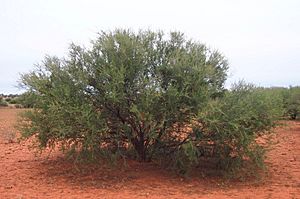Curara facts for kids
Quick facts for kids Curara |
|
|---|---|
 |
|
| Scientific classification | |
| Genus: |
Acacia
|
| Species: |
tetragonophylla
|
 |
|
| Occurrence data from AVH | |
The Acacia tetragonophylla, commonly called curara, kurara, or dead finish, is a type of tree or large bush. It is part of the Fabaceae family, which includes peas and beans. This plant grows naturally only in the dry and semi-dry areas of central and western Australia.
Contents
What Does Curara Look Like?
Curara plants often grow as tall bushes or small trees. They can reach a height of about 1.5 to 5 meters (about 5 to 16 feet). Their branches can be quite tangled and sometimes look a bit messy. The younger branches are smooth.
Like most Acacia species, Curara has special leaf-like parts called phyllodes instead of true leaves. These phyllodes are thin and look like needles. They are usually 1 to 5 centimeters (about 0.4 to 2 inches) long and only about 1 millimeter wide. When they are new, they are soft. But as they get older, they become hard, stiff, and very sharp.
These smooth phyllodes grow in groups of two to six on small, knotty side branches. They can also grow one by one on new shoots. Each phyllode is slender and linear, ending in a sharp point. They often have a five-sided shape when you look at them closely, with five to seven clear lines or nerves. In Western Australia, the Curara blooms with yellow flowers between May and October. These yellow flowers grow in round clusters. After flowering, the plant produces papery seed pods. These pods can be up to 8 centimeters (about 3 inches) long and about 5 millimeters wide.
Where Does Curara Grow?
The Curara plant is found in dry and semi-dry regions across Australia. You can see it growing on flat areas that sometimes flood and along riverbeds. It is common in Western Australia, South Australia, and the southern part of the Northern Territory. It also grows further east, near Charleville in Queensland and Brewarrina in New South Wales. This plant is quite tough and can grow in many different types of soil and environments. In Western Australia, it is found in several regions, including the Pilbara, Gascoyne, Mid West, Wheatbelt, and Goldfields-Esperance areas.
How Scientists Classify Curara
The Curara plant was first officially described by a botanist named Ferdinand von Mueller in 1863. He included it in his scientific work called Fragmenta Phytographiae Australiae. Later, in 2003, another scientist named Leslie Pedley reclassified it. He moved it to a different group called Racosperma tetragonophyllum. However, in 2006, it was moved back to the Acacia group. Sometimes, people confuse the Curara with another similar plant called Acacia sphacelata.
How People Use Curara
Aboriginal people in Central Australia have traditionally used the Curara plant. They collect the seeds from the plant to make special food. These seeds are often ground into a flour to make a type of seedcake. In the Pitjantjatjara language, the name for this plant is Wakalpuka.
The Acacia tetragonophylla has also been used in traditional ways to help with skin growths. People would carefully place parts of the plant into the growth. After a few days, the growth would often shrink and become easier to remove.

